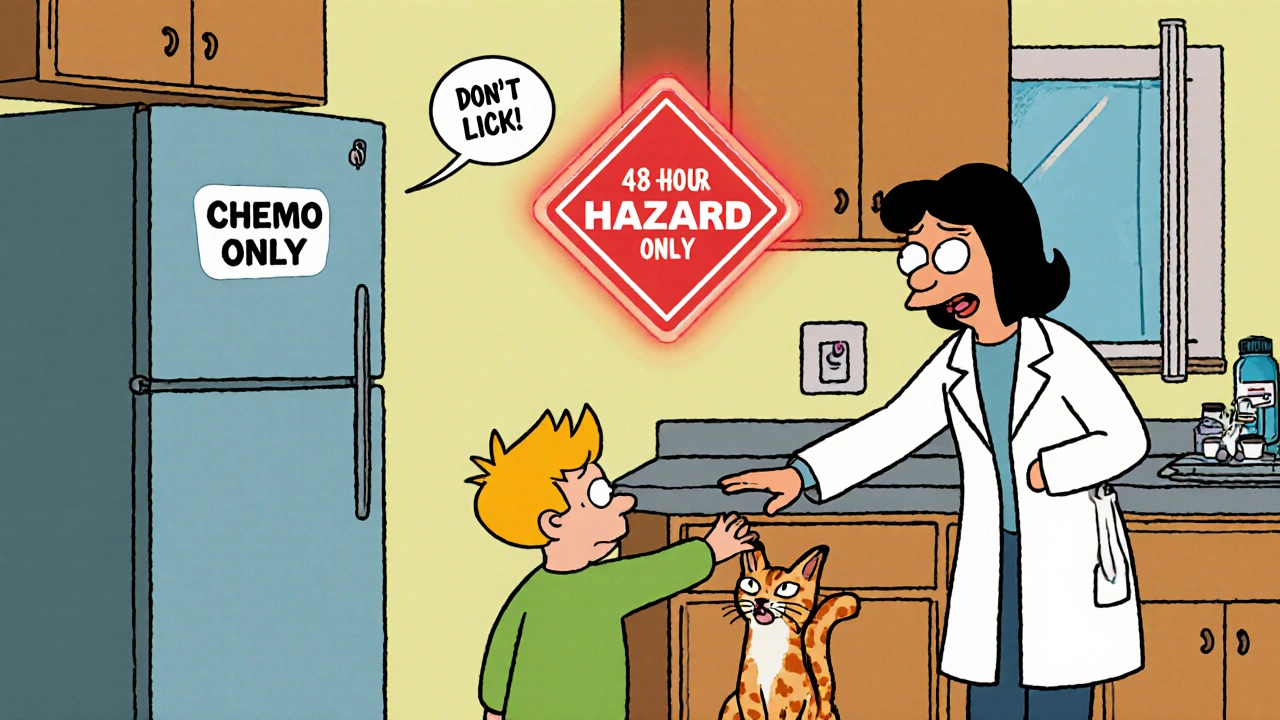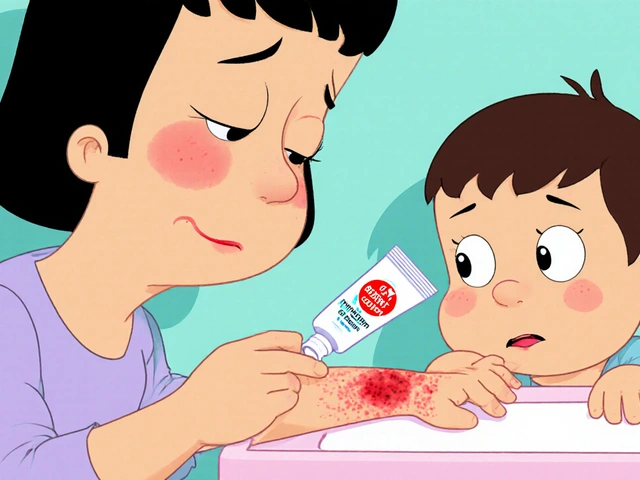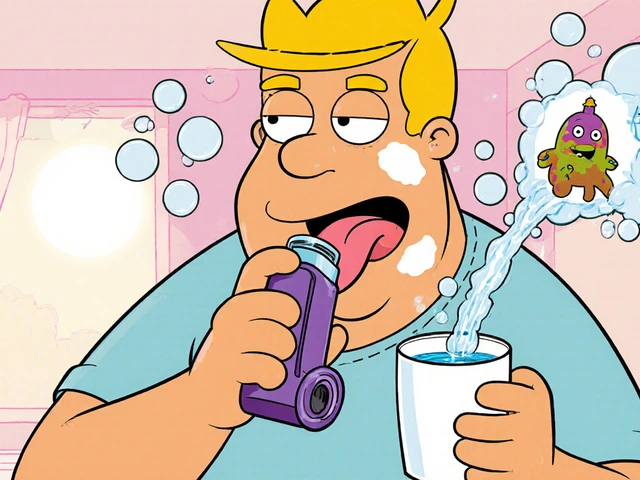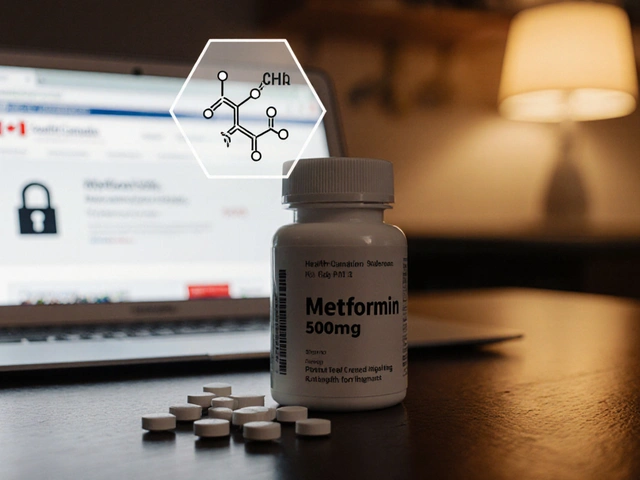Chemo at Home: What You Need to Know for Safety
More than half of cancer patients now receive part of their treatment at home. That means chemotherapy isn’t just happening in hospitals anymore-it’s in kitchens, bedrooms, and bathrooms. And while this gives patients more comfort and control, it also brings real risks. Chemotherapy drugs don’t just kill cancer cells. They can harm anyone who comes into contact with them-caregivers, kids, pets, even neighbors. The good news? With the right steps, you can keep everyone safe. This isn’t about fear. It’s about knowing exactly what to do, when, and why.
Why Chemo Is Dangerous Outside the Hospital
Chemotherapy drugs are powerful. They’re made to destroy fast-growing cells, which is why they work on tumors. But they don’t know the difference between a cancer cell and a healthy one. That’s why nurses wear gloves and masks in clinics. The same rules apply at home. Even tiny amounts of these drugs-on your skin, in your urine, or on a countertop-can cause problems. A 2022 study found that nearly 13% of healthcare workers exposed without protection developed skin rashes or irritation within six months. At home, the risk is higher because people aren’t trained. Kids touch surfaces. Pets lick floors. Caregivers forget gloves. These aren’t hypotheticals. They’re real incidents reported to the CDC and oncology safety hotlines.
How Long Chemo Stays in Your Body (The 48-Hour Rule)
Here’s the most important thing to remember: chemotherapy stays in your body fluids for about 48 hours after your last dose. Some drugs, like cyclophosphamide, stick around for up to 72 hours. That means your urine, sweat, vomit, blood, and even semen or vaginal fluid can carry the drug. During this window, you’re not contagious in the usual sense-but you are hazardous. You don’t need to isolate yourself in a room. But you do need to treat everything you touch as potentially contaminated. Flush the toilet twice with the lid down. Wash your hands for 20 seconds before and after using the bathroom. Don’t let anyone else clean up spills. Use gloves every time you handle anything that might be dirty.
Storage: Keep It Locked, Cool, and Clear
Never leave chemo meds on the counter, in the medicine cabinet, or next to your vitamins. Store them in a locked container-preferably a small cabinet in a closet or bathroom that kids and pets can’t reach. Temperature matters. Some pills need to stay refrigerated between 36°F and 46°F. Others should be kept at room temperature, between 59°F and 86°F. Check the label or ask your pharmacist. If you’re unsure, call the pharmacy that sent the medication. Most cancer centers send out a printed guide with each prescription. Keep it. Use it. Also, never crush, cut, or chew pills. That can turn the drug into dust you can breathe in. Use a dedicated cup to pour pills out, not your fingers. And don’t store chemo near food or regular medicines. Cross-contamination is real.

Handling: Gloves, Spill Kits, and No Shortcuts
If you’re touching chemo meds-or anything that might have touched them-wear gloves. Not just any gloves. Nitrile gloves, at least 5 mil thick. Latex doesn’t block these chemicals. Always wear two pairs. Put the first pair on, then the second. Take them off carefully, turning them inside out as you pull them off. Then wash your hands. Always. Even if you think you didn’t touch anything. Use a chemo spill kit. Most cancer centers give you one. It includes absorbent pads, forceps, disposable bags, and instructions. If a pill drops, don’t pick it up with your fingers. Use the forceps. Wipe the area with the pad. Put everything in the bag. Seal it. Put it in your regular trash-no special medical waste bins needed at home. But never flush pills down the toilet unless your doctor says so. Most can’t be flushed.
Cleaning and Laundry: No Guesswork
Wash your clothes, sheets, and towels separately from everyone else’s. Use hot water-140°F or higher-and regular detergent. Wash twice. Don’t mix chemo-soiled items with baby clothes or pet bedding. If you spill urine or vomit, clean it up immediately with paper towels and the absorbent pads from your spill kit. Wipe the surface twice. Then wash your hands. Don’t use sponges or cloths you reuse. Use disposable ones. If you’re pregnant, trying to get pregnant, or breastfeeding, avoid all contact with chemo meds and contaminated items. Studies show these drugs can show up in breast milk for up to 72 hours after treatment. That’s not a risk you take lightly.
Creating a Chemo Zone in Your Home
Designate one area for handling meds and cleaning up. A bathroom with good ventilation works best. Cover the sink and counter with plastic-backed absorbent pads. Keep your spill kit, gloves, and hand sanitizer there. Use a separate cup for pills. Keep a small trash can just for chemo waste. Label it. This isn’t about making your home look like a hospital. It’s about reducing chances of mistakes. After you take your pill, wash your hands. Put the cup in the sink. Put the empty blister pack in the chemo trash. Flush twice. Wash your hands again. Do this every time. Make it a routine. The more automatic it becomes, the safer you are.
Disposal: What Goes in the Trash (And What Doesn’t)
Here’s a common mistake: people think chemo waste needs special disposal. It doesn’t-at home. Gloves, pads, used cups, empty pill bottles, and even soiled tissues all go in your regular household trash. You don’t need medical waste containers. That’s for hospitals. But here’s the catch: don’t put unused pills in the trash unless you’re instructed to. Some drugs require return to the pharmacy or special take-back programs. Check the label or call your oncology nurse. If you’re unsure, call the Oncology Nursing Society’s 24/7 hotline: 1-866-877-7851. They’ve answered over 12,000 calls in 2022. They know what to do.

Technology Is Helping-But Not Replacing Common Sense
Smart pill dispensers like MedMinder Pro Chemo now beep reminders and log when you take your meds. They even give voice instructions like, “Wear gloves before handling.” These tools are great, especially for people who are tired or confused. But they don’t replace the basics. You still need gloves. You still need to flush twice. You still need to wash your hands. Technology helps you remember. It doesn’t protect you. The real safety comes from habits. Train everyone in your household. Kids should know not to touch the chemo cabinet. Pets should be kept away from the bathroom during the 48-hour window. Neighbors shouldn’t be asked to pick up trash that might be contaminated.
What If You Make a Mistake?
Accidents happen. You forgot gloves. You touched a pill. You didn’t flush twice. Don’t panic. Wash your hands immediately. Call your oncology nurse or the NIOSH/ONS hotline. Don’t wait. Most exposures are minor and don’t cause lasting harm if caught early. But ignoring them? That’s dangerous. Keep a chemo diary. Write down when you take each dose. That helps you track the 48-hour window. If you’re unsure whether it’s safe for someone to hug you, check the diary. If it’s been less than two days? Wait. It’s better to be cautious than sorry.
Why This Matters More Than Ever
By 2030, up to 80% of cancer treatments will happen at home. That’s not a guess. It’s a projection from the American Society of Clinical Oncology. More people are getting chemo pills than IVs. More drugs are being approved. More families are managing this alone. But safety standards haven’t kept up everywhere. A 2022 survey found only 58% of rural patients knew about the 48-hour rule. Urban patients? 82%. That gap is dangerous. If you’re reading this, you’re already ahead. You’re learning. You’re asking questions. That’s the first step to safety.
What You Can Do Today
- Find your chemo spill kit. If you don’t have one, call your oncology center-they’ll send one for free.
- Lock up your meds. Even if you think no one will touch them.
- Wear two pairs of nitrile gloves the next time you handle pills.
- Flush the toilet twice with the lid down tonight.
- Call 1-866-877-7851 if you have any doubt. No question is too small.
Safety isn’t about perfection. It’s about consistency. One mistake won’t ruin everything. But forgetting gloves every time? That’s how risks build up. You’re not alone. Thousands of families are doing this right. You can too.
Can I hug my kids after taking chemo at home?
Yes, but wait at least 48 hours after your last dose. During that time, avoid close contact like hugging, kissing, or sharing beds. Wash your hands before touching them. If you’ve had vomiting, diarrhea, or sweating heavily, wait 72 hours. The risk is low after 48 hours, but better safe than sorry.
Do I need to wear gloves when taking oral chemo pills?
Yes. Always. Even if the pill looks harmless. Chemo drugs can absorb through your skin. Use nitrile gloves, at least 5 mil thick. Wash your hands before and after. Never handle pills with bare hands. If you drop one, use the forceps from your spill kit-don’t pick it up with your fingers.
Can I wash my chemo clothes with the family’s laundry?
No. Wash chemo-soiled clothes, towels, and sheets separately in hot water (140°F or higher) with regular detergent. Wash them twice. Mixing them with other laundry risks contaminating clothes, towels, and even the washing machine. Use a dedicated hamper for chemo items.
Is it safe to be around pets while on chemo?
Keep pets away from the bathroom and areas where you handle meds. Don’t let them lick your skin, especially after you’ve taken chemo. They can pick up traces of the drug on your skin or from the floor. If they lick urine or vomit, it could make them sick. Use a pet gate or keep them in another room during the 48-hour window after treatment.
What should I do if I spill chemo pills on the floor?
Don’t touch them with your hands. Put on two pairs of nitrile gloves. Use the forceps from your spill kit to pick up the pills. Wipe the area with an absorbent pad. Put everything-pills, pads, gloves-into a sealed plastic bag. Throw the bag in your regular trash. Wash your hands thoroughly. Call your oncology nurse if you’re unsure about the drug or how much was spilled.
Can I take chemo if I’m pregnant or breastfeeding?
If you’re pregnant or breastfeeding, you should not handle chemo meds or come into contact with contaminated materials. Studies show these drugs can pass into breast milk for up to 72 hours after treatment. They can also harm a developing fetus. If you’re pregnant or planning to be, talk to your oncologist before starting treatment. Your care team can adjust your plan to protect you and your baby.
Do I need a special trash can for chemo waste?
No. At home, you can throw gloves, pads, used cups, and empty pill bottles into your regular household trash. You don’t need medical waste containers. Just seal used items in a plastic bag before tossing them. The only exception is unused pills-some require return to the pharmacy. Check your instructions or call your oncology nurse.
What if I forget to wear gloves and touch the pill?
Wash your hands immediately with soap and water for at least 20 seconds. Don’t panic. One-time exposure rarely causes harm. But make a note-write it down in your chemo diary. If you feel any skin irritation, nausea, or dizziness afterward, call your oncology nurse. Going forward, set a reminder: gloves every time, no exceptions.
Are all chemotherapy drugs handled the same way at home?
Most follow the same basic rules-gloves, 48-hour precautions, no crushing pills-but some newer targeted therapies and immunotherapies have different risks. The CDC updated its list in 2023 to include 297 hazardous drugs, including newer ones like sotorasib and dostarlimab. Always check the specific instructions that come with your prescription. If you’re unsure, call the Oncology Nursing Society hotline or your pharmacist.
Where can I get a free chemo safety kit?
Most cancer centers and home health agencies provide free safety kits to patients. They usually include two pairs of nitrile gloves, absorbent pads, forceps, disposal bags, and instructions. If you didn’t get one, call your oncology nurse or the American Cancer Society. You can also download the CDC’s free printable checklist online. Don’t wait-get it before your next dose.






Cynthia Springer
November 26, 2025 AT 10:39I never realized how much goes into this until I read this. I’ve been helping my mom with her oral chemo, and I didn’t even know about the two-glove rule. We’ve been using latex. Yikes. Going to order nitrile today. Also, flushing twice? I thought that was just for poop. Turns out it’s for everything. Thanks for the clarity.
Aaron Whong
November 26, 2025 AT 15:33The ontological weight of chemotherapeutic containment in domestic space is profoundly destabilizing to the Cartesian boundary between self and environment. The pharmacological sublime, once confined to the sterile sanctum of the oncology ward, now permeates the domestic topology-urine, sweat, and exfoliated epithelia become vectors of a bio-political liminality. We are no longer merely patients or caregivers; we are custodians of a hazardous phenomenology.
Sanjay Menon
November 27, 2025 AT 13:43Oh wow. So now we’re supposed to treat our homes like biohazard zones? I mean, I get it, but isn’t this just fearmongering dressed up as ‘safety’? My aunt took chemo for five years and never had a spill kit. She lived to 87. Maybe we’re over-engineering this because we’re scared of death instead of living with it?
Marissa Coratti
November 28, 2025 AT 04:34This is one of the most comprehensive, compassionate, and clinically accurate guides I’ve ever encountered on home-based chemotherapy safety. The emphasis on routine over perfection is not just practical-it’s psychologically vital. The 48-hour rule, the dual-glove protocol, the segregation of laundry, the prohibition against crushing pills-all of these are evidence-based, non-negotiable safeguards. I work in oncology nursing, and I cannot stress enough: this isn’t about being paranoid. It’s about honoring the dignity of the patient and the integrity of the caregiver. Please, if you’re reading this, print this out. Tape it to the fridge. Make it a ritual. Safety is love in action.
Kaushik Das
November 29, 2025 AT 16:48Bro this hit different 😅 I’m from India and my cousin’s wife is on oral chemo. We were using regular gloves from the kitchen and flushing once. Now I’m ordering nitrile gloves from Amazon and printing the CDC checklist. Also, pets? My dog licks everything. Gonna get a baby gate for the bathroom. Thanks for saving my family from a dumb mistake 🙏
Rachel Whip
November 30, 2025 AT 13:21Just wanted to add something important: if you’re using a pill organizer, don’t put chemo pills in it unless it’s designated solely for them. Cross-contamination with other meds is a real risk. Also, if you’re storing refrigerated pills, keep them in a sealed container inside the fridge-away from food. I’ve seen too many cases where chemo meds got mixed with yogurt or milk. It’s not just about gloves. It’s about every single step.
Ezequiel adrian
December 2, 2025 AT 04:34Y’all overthinkin’ this. I took chemo at home for 18 months. Gloves? Nah. Flush once? Yep. Hugged my kids every day. My dog slept on my lap. No rashes, no issues. The system is scared of lawsuits, not science. If your body can handle the drug, it can handle the exposure. Chill. 😎
Amanda Wong
December 3, 2025 AT 09:42Let’s be honest-this is a liability-driven document masquerading as medical advice. The CDC doesn’t have a single peer-reviewed study proving that flushing twice reduces systemic exposure in household members. The 48-hour rule is based on pharmacokinetics of a handful of drugs, not all 297 hazardous agents. And who exactly is supposed to enforce ‘no hugging’? This reads like a hospital’s legal department wrote it after a lawsuit. The real danger is anxiety, not the pills.
Deborah Williams
December 4, 2025 AT 00:16There’s a quiet, unspoken truth here: we’ve outsourced caregiving to the internet because we’re too exhausted to ask our doctors. This post doesn’t just teach you how to handle pills-it teaches you how to be a human in a system that treats you like a risk factor. The gloves, the flushes, the separate laundry-they’re not just protocols. They’re acts of resistance against a world that wants you to disappear quietly. You’re not a burden. You’re a person trying to stay alive. And that’s worth every second of this ritual.
Asia Roveda
December 5, 2025 AT 21:00Why are we letting Big Pharma dictate how we live? Who gave them the right to make us treat our homes like Chernobyl? This isn’t safety-it’s corporate control disguised as care. If they really cared, they’d make non-toxic chemo. Until then, stop gaslighting families into thinking this level of paranoia is ‘normal.’
Micaela Yarman
December 7, 2025 AT 16:43As someone who has managed home-based chemotherapy for two family members across three states, I can confirm: the guidelines in this post are not only accurate, but they are the bare minimum. I once saw a caregiver use a sponge to clean up vomit-then reuse it the next day. The patient developed a severe skin reaction. Please, do not improvise. The spill kit exists for a reason. The gloves exist for a reason. The flushes exist for a reason. These are not suggestions. They are lifelines.
mohit passi
December 7, 2025 AT 23:54Bro this is life changing 🙌 I never knew about the forceps in the spill kit. My wife’s chemo pill rolled under the fridge last week and I picked it up with my fingers. Felt like a monster. Now I got the kit. Also, pets stay out. No more cuddles after 8pm. And yes I flush twice now. Every time. Even if I’m alone. Because I owe her that much ❤️